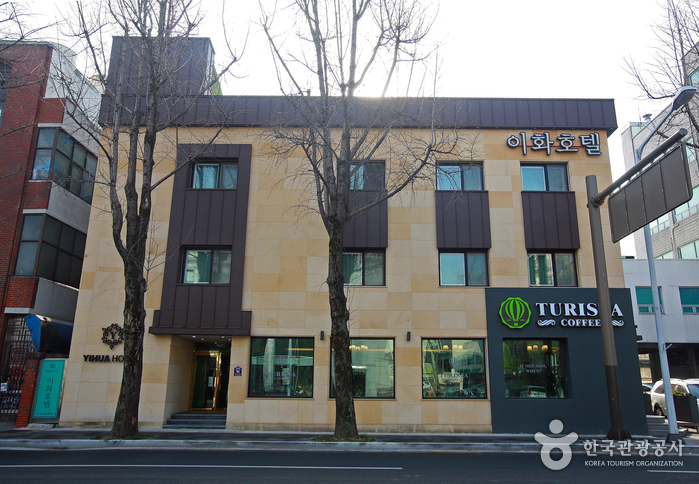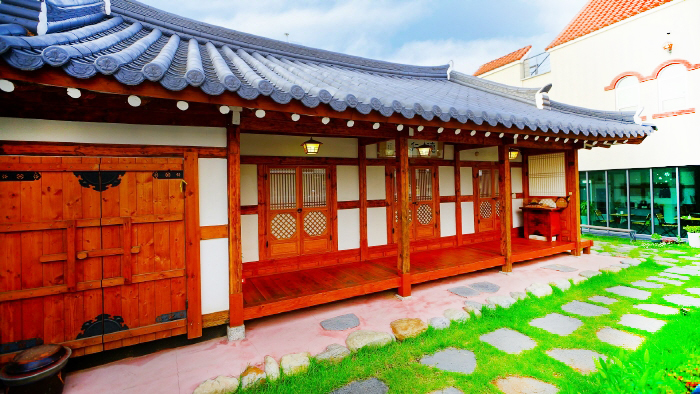Damun (다문)
473.6022342265754m 8127 2024-04-07
74-8, Eunhaeng-ro, Wansan-gu, Jeonju-si, Région Jeonbuk
+82-63-288-8607
Situated in Jeonju Hanok Village, Gyo-dong, Jeonju-si, Damun serves Korean table d’hote in a restaurant divided into large and small rooms within a hanok building structure.
Yeohangga [Korea Quality] / 여행가 [한국관광 품질인증]
496.0278487564528m 9718 2024-04-07
74-11, Eunhaeng-ro, Wansan-gu, Jeonju-si, Région Jeonbuk
+82-63-231-3040, +82-10-7742-6738
Yeohangga is a guesthouse owned and run by a woman who majored in early childhood education and who has been teaching children for over 20 years. The name means "A home for a happy trip," she says. It’s a unique guesthouse since the owner offers various traditional educational games. The cozy and comfortable guesthouse is a traditional Korean house built in March 2013 at a site where an old house used to be. The main building and detached building are divided by the ridge of the roof with beautiful rafters. There is another meaning to the name of the guesthouse: "a house where the woman is happy." She named it as such for a good reason. She used to live in Seoul when her parents advised her to move to Jeonju and run a guesthouse, leaving her husband and child behind. At first, she considered accepting only female guests, but it wasn't an option since most of the people visiting Jeonju are couples and groups of friends. Instead, she made sure the guesthouse is safe for women while building the house. Many female tourists traveling alone find this a great feature of the guesthouse because they feel safer during their stay. For one, she installed three doors for the rooms (1 transparent door, 1 opaque glass door, and a traditional Korean door). Not only do the guests feel safer; the rooms are also well-insulated thanks to the triple doors. The floors and walls are covered with traditional Korean paper coated with soybean oil, which is very environment-friendly. In the four rooms named “Spring,” “Summer,” “Autumn,” and “Winter,” there are many toys and materials for traditional Korean cognition games, such as “Chilgyo Game,” “Gonu Game,” and “Mabangjin.” It’s very likely that even Koreans have never heard of these games. The owner of the guesthouse chose these games specifically because they are perfect for children to play in a traditional Korean house. She teaches her little guests how to play the games. “Chilgyo Game” involves making a shape with 7 to 20 pieces, whereas “Gonu Game” is similar to the game of Chinese chess. "Mabangjin" is a type of IQ game that involves laying down a total of nine different numbers in three rows and columns so that the sum of the three numbers is identical when added horizontally, vertically, or diagonally. Many guests find these games interesting, and the owner of the guesthouse finds joy in teaching these games to as many families as possible. She recently took over another traditional Korean guesthouse called "Samrakheon" near the Jeonju Oriental Medicine Center. It's a stand-alone guesthouse for groups and families, and she uses the place to teach traditional games to more people.
Yangsajae [Korea Quality] / 문화공간 양사재 [한국관광 품질인증]
512.6644871394395m 14399 2024-04-07
40, Omokdae-gil, Wansan-gu, Jeonju-si, Région Jeonbuk
+82-63-282-4959
Located in Jeonju Hanok Village, Yangsajae was the place where the poet Lee Byeong-gi (pen-name: Garam, sijo poet) composed his sijo (a Korean traditional poetic form) works. Now used as a cultural space, the house attracts many people looking for relaxation and cultural experiences.
Yangsajae, meaning “a house (jae) that cultivates (yang) classical scholars (sa)”, was an annex of the Jeonjuhyanggyo Confucian School where classical scholars used to study in preparation for the national civil service examinations. As an educational and creative place, Lee Byeong-gi composed sijo poems there for six years from 1951. It later served as the Jeonbuk Public Elementary School with the introduction of new learning to the Jeollabuk-do area in 1987. Since 2002, however, it has served as a hanok stay dedicated to promoting local history and traditions to the public. It is said that the building was constructed on a 400-year-old site about 150 years ago. In 1980, repair work was conducted to save the basic structure of the house.
The house is a typical ‘ㄱ’-shaped hanok structure with a half-hipped roof. In particular, the three dormitory rooms originally used by Confucian students and classical scholars can be converted into one single room for seminars, tea ceremonies, or other group meetings simply by opening the bunhapmun (sliding doors).
The guesthouse is a ‘ㅡ’-shaped hanok built in 1980. Each room has a clean and cozy interior with simple decoration and furniture. The rooms include the Gudeul (floor heated with firewood) Room, where the tea ceremony program using green tea leaves picked from the wild green tea field behind the house is held, and the Ondol (Korean floor heating system) Room.
As the poet Lee, who loved orchids, poems and alcohol, lived at Yangsajae, there are still traces of his former presence inside the house. Notably, Lee used the ‘Garamdasil’ room as his study room, so it displays some of his photos.
There is a postbox situated in a corner of the yard which the guests can use, and the owner will deliver the mail himself. Yangsajae is not only a hanok accommodation but also a multi-experience space where guests can discover traces of the old educational institute and the poet Lee’s life and works.
Blueboat guest house Jeonju [Korea Quality] / 블루보트게스트하우스 전주점 [한국관광 품질인증]
526.1807698251113m 764 2024-04-07
2nd floor, 75, Chunggyeong-ro, Wansan-gu, Jeonju-si, Région Jeonbuk
+82-10-6545-9049
'Blueboat Hostel Jeonju is one of guesthouses of the 'The Guest House' chain in Busan, Seoul, and Gyeongju. Blueboat Hostel Jeonju opened in April 2016 in Gyeongwon-dong, Jeonju-si, which is only 10 minutes away from Gyeonggijeon Shrine on foot. A number of other popular tourist destinations including Jeonju Hanok Village, Jeongdong Cathedral, and Nammun Market are also within walking distance. The hostel has seven guestrooms furnished with steel frame beds. The bathrooms and kitchen are shared among the guests, and there is a television in the kitchen. The rooms have a trendy interior design because it's mostly visited by young tourists. The guesthouse is just like one of those you can find in other countries, except cleaner.
Yihua Hotel
542.3902991696527m 1229 2024-04-07
76, Jeollagamyeong-ro, Wansan-gu, Jeonju-si, Région Jeonbuk
+82-63-284-6699
As a three-story building with a basement floor, Jeonju Yihua Hotel is located in Jeon-dong in the eastern part of Jeonju Hanok Village. It's a medium-sized hotel with 26 Suite, Standard Double, Standard Korean-style, and Deluxe Twin rooms. The room rates are reasonable for both tourists and business travelers. The front desk lobby is on the 1st floor, and the rooms are on the 2nd and 3rd floors. Facing the front desk are a computer with Internet connection and a printer as well as a microwave oven. The 1st floor of the hotel is rented to a cafe named "Turista," which is popular for its brunch. Many guests staying at Yihua Hotel have brunch here before taking a tour of Jeonju. Nearby tourist destinations include Gyeonggijeon Shrine, Jeondong Catholic Cathedral, Jeonju Hanok Village, JIFF (Jeonju International Film Festival) Street, and Pungpae Jigwan (Jeonju Inn). The Gyeonggijeon Shrine, Jeonju JIFF Street, and Pungnammun Gate are 3 minutes, 5 minutes, and 3 minutes away from the hotel on foot, making it a popular place to stay among Korean and foreign tourists.
Village des peintures murales de Jaman (자만벽화마을 - 외국어사이트용)
551.9692055514231m 273 2024-04-07
1-10, Jamandong 1-gil, Wansan-gu, Jeonju-si, Région Jeonbuk
Le village des peintures murales de Jaman est un petit village situé en face du village hanok de Jeonju, sur la colline d’une montagne. On peut trouver des maisons alignées les unes aux autres sur les pentes du village, sur les murs on trouve des peintures de toutes les couleurs.
Deokindang
582.2937357551441m 942 2024-04-07
28-3, Pungnammun 3-gil, Wansan-gu, Jeonju-si, Région Jeonbuk
063-282-6336, 010-5654-3554
Deokindang is located across from the west street of Jeonju Hanok Village. The guesthouse is surrounded by low walls, inside of which there are grass yard, stone pavement, and four traditional houses with three guestrooms, which are called the Large Room, Small Room, and Kitchen Room. Here, the "Kitchen Room” is not actually a kitchen, but a kitchen turned into a bedroom. The Large Room in the center of the main building can accommodate up to 8 people, making it a perfect place to stay for a large family. It’s furnished with thin, white calico sheets, which are very soft to the touch.
Situated on the outskirts of Jeonju Hanok Village and yet very close to Gyeonggijeon Shrine, Jeondong Catholic Cathedral, Nambu Market, and Jeonju Pungpae Jigwan (Jeongju Gaeksa. Treasure No. 583), the guesthouse is quiet and conveniently located as well for those taking a tour of Jeonju. The owner of Deokindang also owns another guesthouse called Su House, so the guests of Deokindang can have access to the Community Room of Su House.
Yedawon [Korea Quality] / 예다원 [한국관광 품질인증]
585.2095537501809m 184 2024-04-07
85-34, Hyanggyo-gil, Wansan-gu, Jeonju-si, Région Jeonbuk
+82-63-228-8218
Sitting at the foot of Omokdae, Yedawon is a classic Hanok opened in December 2013. It retains the unique beauty of Hanok, yet is equipped with neat and convenient facilities. The owner, who used to operate a traditional culture space for Hanok experience such as traditional tea and natural dying, newly built a Hanok for guests to be able to experience a cultural accommodation. Just one-minute away are Jeonjuhyangyo Confucian School and Jeonju Hanbyuk Culture Center, whereas the National Intangible Heritage Center is located over the Omokgyo Bridge outside the culture center. Gyenggijeon, Jeondong Catholic Cathedral, Omokgyo Bridge, and Nambu Market are all within walkable distance.
Yeodawon has six rooms named after flowers; ceilings with exposed rafters and crossbeams; walls with Hanji wallpapers; and decorations with black-and-white drawings and Korean calligraphy. In particular, Lotus Flower Room is furnished with a folding screen with a landscape painting on it, and a big black-and-white drawing.
Yeodawon is special in that guests can get first-hand experience of the traditional culture in different ways: traditional tea, traditional dying, Hanji, traditional dessert, traditional flower pancake, etc. The experience costs about 10,000 - 15,000 won per person, and available for four persons or more.
Porte Pungnammun (전주 풍남문)
588.6471258899865m 5395 2024-04-08
1, Pungnammun3(sam)-gil, Wansan-gu, Jeonju-si, Région Jeonbuk
+82-63-287-6008
La porte Pungnammun a été construite dans le milieu du royaume de Jeoson (1768) et désignée trésor national no 308. Des 4 portes originales, c’est la seule qui reste (dans la partie sud de la ville). Sa structure a été partiellement détruite lors de l’invasion des forces étrangères de 1592 à 1598. Et a été reconstruite en 1978. Jungcheung et mullu sont au centre de la porte, épousant la forme de l’arche. Ces formes particulières forment le symbole du potentiel protecteur de la porte Pungnammun tout comme ils forment le symbole de sa grandeur.
Cathédrale Jeondong (전주전동성당)
593.5058598662189m 7513 2024-04-08
51, Taejo-ro, Wansan-gu, Jeonju-si, Région Jeonbuk
Cette cathédrale bâtie en 1914 dans un style occidental est classé trésor national numéro 288. Il s’agit de la plus grande structure des deux provinces du Jeollado. La large façade en briques rouge ainsi que l’entrée et le clocher sont assez impressionnants en hiver. La voûte d’entrée rappelle le style byzantin, tandis que le petit clocher situé au centre ajoute un charme particulier. Malheureusement une partie de la cathédrale fut détruite dans un incendie en 1988.
La cathédrale de Jeondong a été construite en honneur des catholiques martyrs durant la dynastie Joseon. Le terrain fut acheté par le moine français Baudenet en 1891 (28ème année de règne du roi Gojong). On doit l'architecture du site au prêtre Poinel qui est aussi à l'original de la cathédrale de Myeongdong à Seoul.

![Yeohangga [Korea Quality] / 여행가 [한국관광 품질인증]](http://tong.visitkorea.or.kr/cms/resource/63/2572563_image2_1.jpg)
![Yangsajae [Korea Quality] / 문화공간 양사재 [한국관광 품질인증]](http://tong.visitkorea.or.kr/cms/resource/75/1879875_image2_1.jpg)



![Yedawon [Korea Quality] / 예다원 [한국관광 품질인증]](http://tong.visitkorea.or.kr/cms/resource/91/2594991_image2_1.jpg)


 Français
Français
 한국어
한국어 English
English 日本語
日本語 中文(简体)
中文(简体) Deutsch
Deutsch Español
Español Русский
Русский